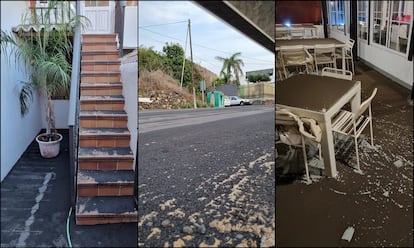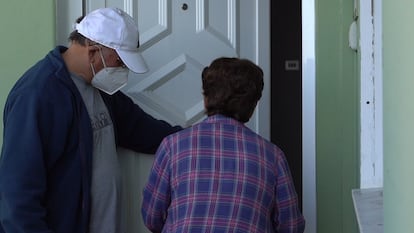La Palma volcano evacuees start to go home: ‘It’s very dirty, it’s very sad’
Around 1,000 people were told it was safe to return on Monday, out of a total of 7,000 who lost their houses to the three-month eruption on the Spanish island
Abraham Rodríguez had a bittersweet feeling when he returned home with the furniture his family had taken away weeks earlier, back when they thought it might get destroyed by the volcanic eruption on La Palma, one of Spain’s Canary Islands.
“On the one hand I am happy, I was really looking forward to going back. But on the other I am very sad for relatives who lived nearby and who have lost everything,” said the 18-year-old student from Las Martelas, a neighborhood in the town of Los Llanos de Aridane that was evacuated on October 19 and now looks “like an abandoned place.”
“It’s a very strange feeling. The whole house is full of ash. It’s very dirty, it’s very sad,” said Rodríguez in a telephone conversation. His family had placed some of the furniture in storage ahead of the evacuation, but a few items were left behind and are now covered in volcanic ash. “It was risky to leave things behind, but we’d been hoping the lava would not reach them.”
After three months of volcanic activity, the eruption was officially declared over on Christmas Day, and around 1,000 people were told they could go home starting on Monday. But there are nearly 4,000 more waiting for permission to return, while a further 2,329 people have lost their homes to the lava.

The eruption – the longest experienced on La Palma in 375 years – also battered the tourism and agriculture-based economy of this island, located off the northwestern coast of Africa.
Over the course of 85 days, the lava covered 1,219 hectares of land within a perimeter of around 69 kilometers. It destroyed 1,676 buildings – including 1,345 homes – as well as nearly 74 kilometers of roads and 370 hectares of cropland, most of which was being used to grow bananas, the island’s best-known export. Locals are now tallying up the damages and asking the government for more help.
Residents whose houses are still standing in the worst-affected areas of El Paso, Tazacorte, Los Llanos de Aridane and Fuencaliente started to go back on Monday, either to check the state of their homes or, for the lucky ones like Rodríguez, to move back in.
“Last week I went back with the Military Emergency Unit [UME] and other neighbors to measure gas levels and see if I could go home. The results were good,” said Pascual Sánchez, a 50-year-old carpenter who lives in El Charco (Fuencaliente). He figures that after some in-depth cleaning and repairs to damage from the earthquakes, he will be ready to move back in on Wednesday.

The regional government of the Canary Islands said in a statement that a new safe zone will be proposed in the coming days that might allow more people from other parts of La Palma to go home. But the executive underscored that “as long as the necessary safety requirements are not met, it will be impossible to authorize the return of people to other areas that were evacuated.”
Returning residents have been warned not to enter low-lying spaces such as storage rooms, garages or basements without first getting a reading on gas levels. Buildings should be ventilated for 15 minutes before going inside, and walls and ceilings checked for cracks or any other signs of structural damage. Government technicians and members of the Red Cross have been assisting homeowners with these tasks.
Tu suscripción se está usando en otro dispositivo
¿Quieres añadir otro usuario a tu suscripción?
Si continúas leyendo en este dispositivo, no se podrá leer en el otro.
FlechaTu suscripción se está usando en otro dispositivo y solo puedes acceder a EL PAÍS desde un dispositivo a la vez.
Si quieres compartir tu cuenta, cambia tu suscripción a la modalidad Premium, así podrás añadir otro usuario. Cada uno accederá con su propia cuenta de email, lo que os permitirá personalizar vuestra experiencia en EL PAÍS.
¿Tienes una suscripción de empresa? Accede aquí para contratar más cuentas.
En el caso de no saber quién está usando tu cuenta, te recomendamos cambiar tu contraseña aquí.
Si decides continuar compartiendo tu cuenta, este mensaje se mostrará en tu dispositivo y en el de la otra persona que está usando tu cuenta de forma indefinida, afectando a tu experiencia de lectura. Puedes consultar aquí los términos y condiciones de la suscripción digital.
More information
Últimas noticias
Most viewed
- Reinhard Genzel, Nobel laureate in physics: ‘One-minute videos will never give you the truth’
- Oona Chaplin: ‘I told James Cameron that I was living in a treehouse and starting a permaculture project with a friend’
- Pablo Escobar’s hippos: A serious environmental problem, 40 years on
- Why we lost the habit of sleeping in two segments and how that changed our sense of time
- Charles Dubouloz, mountaineering star, retires at 36 with a farewell tour inspired by Walter Bonatti











































